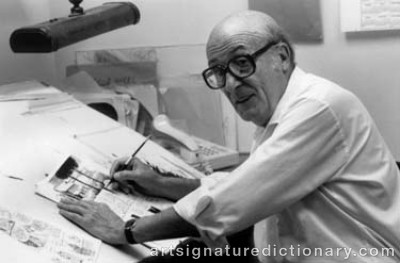
Will EISNER
1917–2005, USA
Biography
Discover the life and artistic journey of Will, William Erwin EISNER (born 1917, 6/3, USA, died 2005, 3/1, USA), including key biographical details that provide essential context for signature authentication and artwork verification. Understanding an artist's background, artistic periods, and career timeline is crucial for distinguishing authentic signatures from forgeries.
WILL EISNER was born William Erwin Eisner on March 6, 1917 in Brooklyn, New York. By the time of his death on January 3, 2005, following complications from open heart surgery, Eisner was recognized internationally as one of the giants in the field of sequential art, a term he coined.
In a career that spanned nearly seventy years and eight decades — from the dawn of the comic book to the advent of digital comics — he truly was the 'Orson Welles of comics' and the 'father of the Graphic Novel'. He broke new ground in the development of visual narrative and the language of comics and was the creator of The Spirit, John Law, Lady Luck, Mr. Mystic, Uncle Sam, Blackhawk, Sheena and countless others.
One of the comic industry's most prestigious awards, The Eisner Award, is named after him. Recognized as the 'Oscars' of the American comic book business, the Eisners are presented annually before a packed ballroom at Comi-Con International in San Diego, America's largest comics convention.
Will Eisner was the son of Jewish immigrants, his early life and experiences growing up in New York tenements would become the inspiration for much of his graphic novel work. At DeWitt Clinton High School in the Bronx, Eisner's budding interest in art was fostered, and it was in the school newspaper that his first work was published. Eisner's first comic work appeared in 1936, kicking off a unique and groundbreaking career spanning almost seven decades.
Explore other artists
Discover other notable artists who were contemporaries of Will EISNER. These artists worked during the same period, offering valuable insights into artistic movements, signature styles, and authentication practices. Exploring related artists makes it easier to recognize common characteristics and artistic conventions of their era.